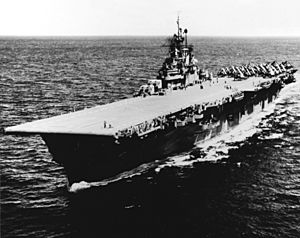USS Bunker Hill (CV-17) facts for kids
class="infobox " style="float: right; clear: right; width: 315px; border-spacing: 2px; text-align: left; font-size: 90%;"
| colspan="2" style="text-align: center; font-size: 90%; line-height: 1.5em;" | 
|} The USS Bunker Hill (CV-17) was a famous aircraft carrier that served in the United States Navy. It was one of 24 Essex-class carriers built during World War II. The ship was named after the Battle of Bunker Hill, an important battle in the American Revolutionary War. It began its service in May 1943.
Contents
| History | |
|---|---|
| Name | Bunker Hill |
| Namesake | Battle of Bunker Hill |
| Builder | Fore River Shipyard |
| Laid down | 15 September 1941 |
| Launched | 7 December 1942 |
| Commissioned | 25 May 1943 |
| Decommissioned | 9 January 1947 |
| Reclassified |
|
| Stricken | 2 November 1966 |
| Motto | Never Surrender, Never Sink |
| Nickname(s) | Holiday Express |
| Honors and awards |
|
| Fate | Sold for scrap in 1973 |
| General characteristics | |
| Class and type | Essex-class aircraft carrier |
| Displacement |
|
| Length |
|
| Beam |
|
| Draft |
|
| Installed power |
|
| Propulsion | 4 × shafts; 4 × geared steam turbines |
| Speed | 33 knots (61 km/h; 38 mph) |
| Range | 14,100 nmi (26,100 km; 16,200 mi) at 20 knots (37 km/h; 23 mph) |
| Complement | 2,600 |
| Armament |
|
| Armor |
|
| Aircraft carried | 90–100 |
A Powerful Warship
The Bunker Hill was a very large and powerful ship for its time. It could carry about 90 to 100 aircraft, including fighter planes and bombers. These planes would take off from and land on its long flight deck. The ship also had many guns for defense. It needed a crew of about 2,600 sailors to operate everything.
Building the Bunker Hill
The ship was built at the Fore River Shipyard in Quincy, Massachusetts. Construction started on September 15, 1941. It was launched into the water on December 7, 1942, and officially joined the Navy on May 25, 1943. Building such a huge ship so quickly was a big achievement during wartime.
Service in World War II
The Bunker Hill played a major role in many important battles during World War II, especially in the Pacific Ocean. Its aircraft helped attack enemy ships, submarines, and land targets. The carrier was known for its speed and ability to launch many planes quickly.
Key Battles and Operations
The Bunker Hill participated in several major campaigns against Japan. These included:
- The Battle of the Philippine Sea in June 1944, where it helped defeat the Japanese fleet.
- The Battle of Leyte Gulf in October 1944, one of the largest naval battles in history.
- Supporting the invasions of Iwo Jima and Okinawa in 1945.
The ship's planes often flew dangerous missions. They helped clear the way for Allied forces to land on islands held by Japan.
The Kamikaze Attack
While covering the invasion of Okinawa in May 1945, the Bunker Hill faced a severe challenge. It was hit by two kamikaze planes. Kamikaze were Japanese pilots who deliberately crashed their planes into enemy ships.
The attacks happened very quickly, one after the other. The planes caused huge fires and explosions on the ship's deck and inside. Many parts of the ship were badly damaged. The crew worked bravely to fight the fires and help their injured shipmates. Despite the severe damage and many sailors being injured or lost, the Bunker Hill did not sink. This showed the strength of the ship and the courage of its crew.
After the War
After the war, the Bunker Hill was repaired but was no longer needed for active combat. It was taken out of service in January 1947. Over the years, it was reclassified several times, meaning its official purpose changed. It was considered for different roles, like an anti-submarine carrier or an aircraft transport ship.
The Bunker Hill was finally removed from the Navy's list of ships in November 1966. It was sold for scrap in 1973, ending its long and historic journey.
Images for kids
See also
 In Spanish: USS Bunker Hill (CV-17) para niños
In Spanish: USS Bunker Hill (CV-17) para niños




